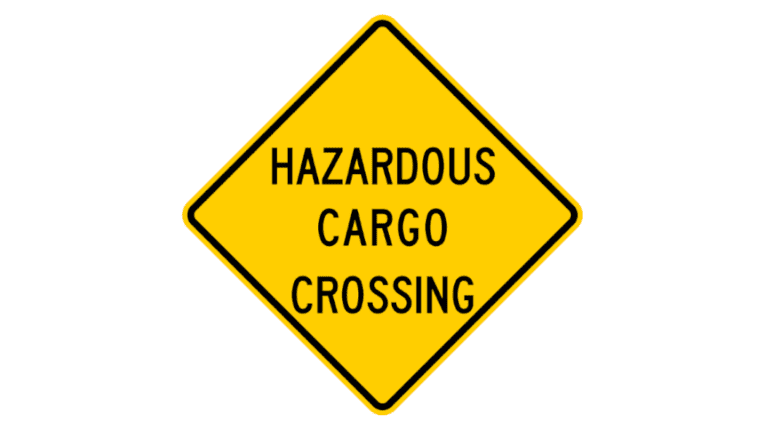by Michael F. Gorman, University of Dayton, [This article first appeared in The Conversation, republished with permission]
Less than two weeks after train cars filled with hazardous chemicals derailed in Ohio and caught fire, a truck carrying nitric acid crashed on a major highway outside Tucson, Arizona, killing the driver and releasing toxic chemicals into the air.
The Arizona hazmat disaster shut down Interstate 10, a major cross-country highway, and forced evacuations in surrounding neighborhoods.
But the highway crash didn’t draw national attention the way the train derailment did, or trigger a flood of calls for more trucking regulation like the U.S. is seeing for train regulation. Truck crashes tend to be local and less dramatic than a pile of derailed train cars on fire, even if they’re deadlier.
In fact, federal data shows that rail has had far fewer incidents, deaths and damage when moving hazardous materials in the U.S. than trucks.
Trucks carry more hazmat and more risk
At one time, rail and water were the only options for transporting chemicals and other potentially dangerous materials. The emergence of the automobile and subsequent construction of the interstate highway system changed that, and hazardous materials shipments by road steadily increased.
Today, trucks carry the largest percentage of hazardous materials shipped in the U.S. – about twice as much as trains when measured in ton-miles, according to the Department of Transportation’s Bureau of Transportation Statistics’ latest data, for 2017. A ton-mile is one ton shipped for one mile.
While truck incidents involving hazardous materials don’t look as dramatic as train derailments and are not as widely covered by news media, federal data shows they represent more fatalities and property damage, and there are thousands more of them every year.
Truck-related hazardous materials incidents caused over 16 times more fatalities from 1975 to 2021 – 380 for truck, compared with 23 for rail, according to the Bureau of Transportation Statistics. The difference is more pronounced in the last decade, when U.S. rail transportation of hazardous materials caused zero fatalities and truck incidents were responsible for 83.
Trucks have also caused nearly three times as much property damage as rail incidents since 2000. That might seem surprising since derailments can involve several cars with hazardous materials. But most rail events take place in remote areas, limiting their human impact, while trucks travel on highways with other drivers around and often in busy urban areas.
Where do we go from here?
I study rail systems and regulation, and I have followed the increasing costs to the industry to comply with tightening regulatory rules.
Shipping hazardous materials in the U.S. has been regulated for over 150 years. A deadly explosion in San Francisco in 1866 involving a just-arrived cargo of nitroglycerin, used for blasting rock, led to the first federal laws regulating shipping explosives and flammable materials.
The Sept. 11, 2001, terrorist attacks spurred a vast expansion of regulation over movement of hazardous materials. Many cities now have hazardous materials routes for trucks that circumvent city centers to reduce the potential risk to high-population areas.
With the Ohio train derailment now making national news, lawmakers are focusing on regulations specifically for rail.
Ohio’s governor wants rail companies to be required to notify states of all hazardous shipments. This knee-jerk reaction to a major event would appear to be a responsible demand with relatively low costs, but it would have no impact whatsoever on prevention of hazmat events.
Activists are calling for more expensive investments, including requirements for heat sensors on train bearings, which appeared to have been involved in the Ohio derailment, and the restoration of a rule requiring advanced braking systems for trains carrying hazardous materials. Both would raise the cost of rail shipping and could wind up putting more hazardous materials shipments on U.S. roads. The Trump administration repealed the braking system requirement in 2017, arguing that the costs outweighed the benefits.
U.S. Transportation Secretary Pete Buttigieg, speaking with reporters, discussed looking into new rules for advanced braking systems, higher fines and encouraging rail companies to speed up their phase-in of more puncture-resistant tank cars.
Rail is still more economical and better for the environment than trucks for longer distances, but with ever-increasing regulations, rail transport can be economically and logistically discouraged – chasing more traffic to far more dangerous roadways.
If the concern is the public’s exposure to hazardous materials, regulation on road-based hazardous materials transportation should expand as well.
Michael F. Gorman, Professor of Business Analytics and Operations Management, University of Dayton
This article is republished from The Conversation under a Creative Commons license. Read the original article.
